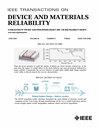Y2O3栅极介质顶门控碳纳米管薄膜晶体管的负偏置温度不稳定性
IF 2.5
3区 工程技术
Q2 ENGINEERING, ELECTRICAL & ELECTRONIC
IEEE Transactions on Device and Materials Reliability
Pub Date : 2023-10-05
DOI:10.1109/TDMR.2023.3322157
引用次数: 0
摘要
首次研究了以氧化钇(Y2O3)为介质的顶门控p型碳纳米管薄膜晶体管(TFTs)在不同栅极偏压、应力和弛豫时间下的负偏置温度不稳定性(NBTI)。观察到正的和快速的可逆阈值电压漂移以及亚阈值和跨电导的显著退化。实验结果基本排除了环境条件的影响,认为这些碳纳米管器件中的NBTI主要是由于介电/碳纳米管界面附近产生了大量的界面陷阱和边界陷阱,突出了界面优化对未来碳纳米管tft的重要性。讨论了应力和恢复过程中的滞后特性,进一步探讨了应力诱导圈闭的性质。这些结果可为进一步研究Y2O3电介质碳纳米管tft栅氧化可靠性提供参考。本文章由计算机程序翻译,如有差异,请以英文原文为准。
Negative Bias Temperature Instability in Top-Gated Carbon Nanotube Thin Film Transistors With Y2O3 Gate Dielectric
The negative bias temperature instability (NBTI) of the top-gated p-type carbon nanotube (CNT) thin film transistors (TFTs) with yttrium oxide (Y2O3) dielectric is investigated under different gate bias, stress and relaxation time for the first time. Positive and fast reversible threshold voltage shift along with significant degradation of subthreshold and trans-conductance are observed. The effects of ambient condition are basically excluded by experimental results, and the NBTI in these CNT devices is believed to be primarily due to the generation of considerable interface traps and border traps near dielectric/CNT interface, highlighting the importance of the interface optimization for CNT TFTs in the future. The hysteresis characteristics during stress and recovery are discussed as well, to further explore the stress-induced-traps properties. All these results may provide a reference for the future study on the gate oxide reliability of CNT TFTs with Y2O3 dielectric.
求助全文
通过发布文献求助,成功后即可免费获取论文全文。
去求助
来源期刊

IEEE Transactions on Device and Materials Reliability
工程技术-工程:电子与电气
CiteScore
4.80
自引率
5.00%
发文量
71
审稿时长
6-12 weeks
期刊介绍:
The scope of the publication includes, but is not limited to Reliability of: Devices, Materials, Processes, Interfaces, Integrated Microsystems (including MEMS & Sensors), Transistors, Technology (CMOS, BiCMOS, etc.), Integrated Circuits (IC, SSI, MSI, LSI, ULSI, ELSI, etc.), Thin Film Transistor Applications. The measurement and understanding of the reliability of such entities at each phase, from the concept stage through research and development and into manufacturing scale-up, provides the overall database on the reliability of the devices, materials, processes, package and other necessities for the successful introduction of a product to market. This reliability database is the foundation for a quality product, which meets customer expectation. A product so developed has high reliability. High quality will be achieved because product weaknesses will have been found (root cause analysis) and designed out of the final product. This process of ever increasing reliability and quality will result in a superior product. In the end, reliability and quality are not one thing; but in a sense everything, which can be or has to be done to guarantee that the product successfully performs in the field under customer conditions. Our goal is to capture these advances. An additional objective is to focus cross fertilized communication in the state of the art of reliability of electronic materials and devices and provide fundamental understanding of basic phenomena that affect reliability. In addition, the publication is a forum for interdisciplinary studies on reliability. An overall goal is to provide leading edge/state of the art information, which is critically relevant to the creation of reliable products.
 求助内容:
求助内容: 应助结果提醒方式:
应助结果提醒方式:


